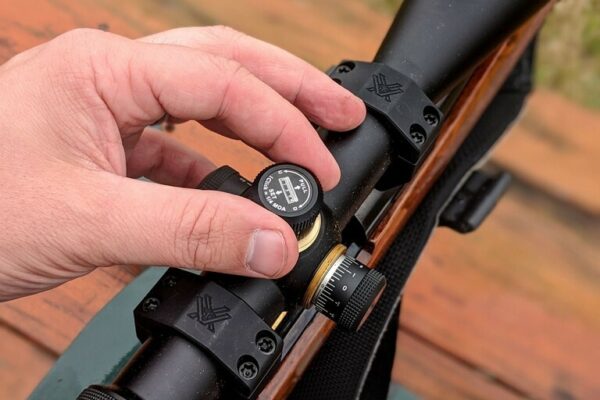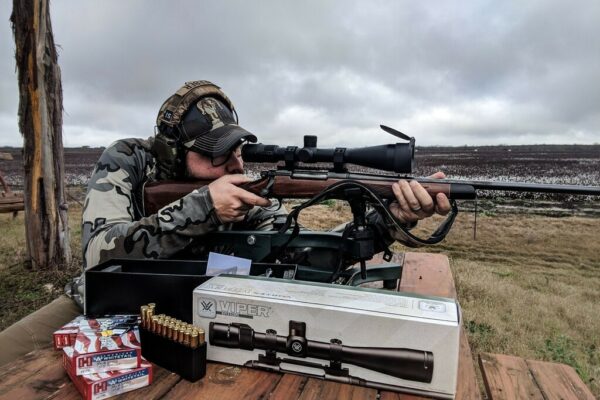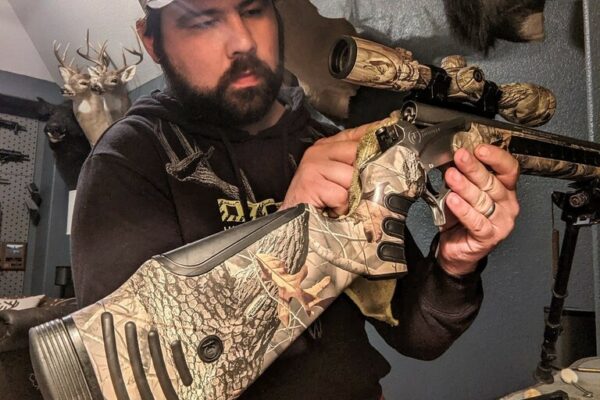By: Mike Reeber
Come the month of May, fishing seems to be more top of mind than thinking about the upcoming deer season. By now, turkey season has closed, it’s starting to push into the upper nineties and exotic hunting is really all that there’s left to hunt this time of the year. So, for those not tuned into watching velvet antlers grow or chasing a summertime axis, many people hit pause until September. And that’s ok, however, there is one thing that you should do now and that’s picking up a new rifle for the upcoming deer season.
Whether it’s your first deer hunting rifle or just another one to add to your collection, buying a rifle during the summer can be beneficial for a number of reasons. For one, it’s not the high season, so you might just get lucky enough to score a rifle at a sale price. Secondly, this gives you time to choose the right optic for it, rather than buying whatever is currently on the shelf in the store. And lastly, it gives you all summer to shoot.
So many choices and so many opinions, ugh.
If you just got into hunting, then it probably didn’t take you long to figure out that everyone has a preference on the caliber that they shoot. Whether they’ve been shooting the same 30-06 for the last 50 years or are into the new fangled 6.5 Creedmoor, caliber is a personal preference that almost isn’t worth getting into a discussion about. The short version of the long story is that if you’re hunting in Texas for a thin-skinned whitetail, you won’t go wrong with many of the popular centerfire calibers. .270, .270WSM 30-06, .308, 300 Win Mag and .243 are among some of the most popular calibers and all of them will do just fine. To me, what’s more important is how the rifle fits you and how well you shoot it.
Buying a rifle at a gun shop can sometimes be a bit of stressful experience, especially if this is new to you. But honestly, there’s nothing to worry about. My suggestion is to go to a locally owned gun shop and tell them what you’re planning on hunting, your budget and if it’s your first time buying a rifle. My guess is that 99.9% of local gun shop owners in our great state are willing to help get you exactly what you’re looking for. Remember, everyone was a first time gun-buyer once.
To me, comfort and fit are the two first things that I look for first. Regardless of whether the stock is synthetic or wood, ensuring that it’s comfortable when shouldered is key. Sometimes even the smallest detail, like checkering on the grip can be a deal breaker if it doesn’t feel right to you. So take your time when you’re handling the rifle and make sure that it has a comfortable feel to it. It’s also important to ensure that it fits correctly. Though many stocks are similar sizes, be sure that it fits well when it’s shouldered and pay specific attention to where the safety is. The last thing that you want is a rifle that has a safety in a weird place, only making it annoying in the field. Trust me, they’re out there.
The next thing to look for is the overall construction of the firearm. If it’s a bolt action rifle, does the action seem smooth when you cycle it or does it seem loose? Whenever possible, try to find something that has tighter tolerances and more of secure fit. Believe me, if you shop for enough rifles, you’ll come across the cheap ones and you’ll be able to spot exactly what I’m talking about. A smooth action will be easier to cycle and will also do a better job at keeping the grit out.
Next is the trigger. Always ask the gun shop owner if you’re able to dry fire the rifle– NEVER DO THIS WITHOUT ASKING. From my experience, some shops are ok with this and others are not. If you’re allowed to do so, always ensure the rifle is unloaded and dry fire it in a safe direction. The trigger can be one of the most important pieces to ensuring a good shot on a deer and a lot of people overlook this. Having a well built trigger means one that has a “clean break”, or in other words, crisp. Some manufacturers install junk triggers that have tons of play in them and ultimately it leaves the shooter wondering when it’s going to go off. This is not good, especially when you have your sights locked in on a buck at 100 yards. Make sure the trigger feels good. This is really important and it will help you in the long run become a better shooter.
Don’t overlook the scope.
One of the most important pieces to your deer hunting rifle is the optic that sits on top. Unfortunately, this sometimes becomes an afterthought when picking up a new rifle, but it shouldn’t be. My biggest piece of advice that I can give regarding scopes, is to buy one that is worth at least as much as the rifle. At first, it might seem a bit crazy, but in the world of scopes, there is a vast difference between average and quality. To be honest, I found this out the tough way. Season after season, I found myself sitting there with a foggy, cloudy or really heavy scope sitting on top of my rifle, not worth a darn. Take your time and find something that is right for your hunting situation. If you’re planning on deer hunting, then having a scope with a 3×9 or even a 4×12 zoom is perfect Texas. This type of magnification range will be great up to a few hundred yards and will also work well in thick brush, where you can zoom it all the way out. Over the years, I’ve had my share of optics, but honestly, the best ones that I’ve found are Vortex. They have great eye relief, which allows me to get on target quickly and I find that their glass is superior to many of the competition. There is never any distortion, especially when it’s zoomed all the way in and I don’t worry one bit when there’s nasty weather because they’re seriously built like tanks. Now, that’s just my preference, but it’s important for you to find something that fits you and your rifle well. Again, choosing a quality optic will make all the difference in the field.
If you’ve ever watched a singing mockingbird, you will have noticed that during his singing, he will suddenly fly straight up for two or three feet and turn a flip in the air—coming back to where he left his perch. The Kokernot Ranch bird did the same thing—up off the antenna and back again, never ceasing to sing.
One summer evening about 5 p.m., I sat in a lawn chair having a cool drink when the old bird came to the antenna and began to sing. I went into the house and got a scrap of paper and pen and came back to my chair. The old bird had been singing all the while. I waited until he mocked a sound that I could remember—the “bobwhite” of a quail. With that, I started counting his songs and making notes.
After a long spell of singing, he came back to the bobwhite call, and I counted the many different calls he had made: 34! I was so amazed that I Googled up the bird, to see if anyone else had counted a mockingbird’s calls during a long singing session. The report noted 35 different calls, so I guess my old bird may have forgotten one.
There has long been debate about mockingbirds. Do they mock other birds, or is their repertoire a natural inheritance? Experts point out the birds repeat the songs of other birds that do not exist in their locale. I think the mockingbird has an inherited vocabulary and doesn’t mock anything.
I enjoyed this mockingbird for about five or six years—then one summer he didn’t come back. He may have decided to change his singing spot, since he had never called in a mate. Or, he may have just died somewhere in his travels—I’ll never know.
All male “mockers” don’t sing like my old bird did. Where there are several birds in one area—both male and female—the male birds hardly ever sing. But when an old bird is all alone on a hill in Gonzales County, perched on a high TV antenna, he will sing his heart out, hoping that some far-away female will hear him and join his company. Woe is the life of a lonely mockingbird.
Depending on how the scope mounts to the rifle, I suggest having a torque wrench nearby to get everything torqued down to spec. Is it necessary, no, but having the piece of mind that your scope is properly tightened down is really nice, especially if you bump it in the blind. When everything is all locked up and ready to roll, get yourself some good ear and eye protection and head to the range to get sighted in.
Once you’re all dialed in and ready to go for the upcoming season, don’t forget to clean your rifle. Believe me that over the course of your hunting travels, you’ll meet folks that haven’t cleaned their favorite rifle in years and to each their own, but I highly recommend it. For me, it’s a piece of mind thing that all of my rifles, shotguns and muzzeloaders aren’t sitting around getting rusty and can possibly have an issue in the field. And honestly, if you keep them clean, they will have no issue lasting for several generations.
A clean rifle is a happy rifle.
In the gun cleaning world, there are literally thousands of products and solutions to keep everything in working order. First and foremost, it’s important to get a caliber specific cleaning kit or a Hoppe’s Boresnake to clean the barrel with. Personally, I find that the Boresnake is just easier to keep around to run through the barrel of a rifle. And, it’s compact enough to just keep tucked away in your gun case. For cleaning products, I’ve always used Seal1 and sincerely like the way that it cleans and protects(as weird as I am, I think that it also has a great smell). They’re a Veteran owned company and since finding their line of cleaning products nearly 10 years ago, I won’t use anything else. Instead of having a full lineup of oils, solvents and cleaners, Seal1 is literally a one and done type of product. I can also attest to the fact that after you use it, your rifle will stay cleaner longer, and who doesn’t want that?
Regardless of what you have in store for this summer, one thing is for certain, make it a priority to get out and shoot. Knowing how your rifle shoots at different yardages seems elementary, but believe me when I say there’s a bunch of people who just shoot at one distance and have no idea what their gun does further out. Be sure to shoot it beyond 100 yards and see what the bullet does. It’s better to know at this point, rather than when you’re sitting in the blind wondering this fall!
Up Next: Five Reasons Why You Need a Trail Cam





